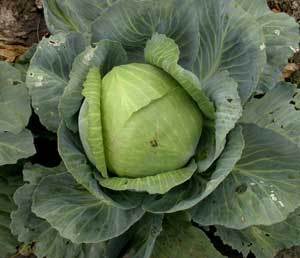
Brassica oleracea (Capitata group)
Cabbage is a low growing vegetable in the Cruciferae family with a large head made up of many layers of thick, succulent leaves.
Cabbage should be planted early in the season so it grows and matures before the arrival of warm weather. Plant a variety of cultivars with different maturity rates to extend the season.
full sun
fertile, well-drained soil with a pH of 6.0 to 6.8
Keep soil evenly moist (not wet).
Seedlings of early cultivars should be thinned to15 to 18 inches apart and late cultivars to 2 feet apart, once they form two true leaves. To avoid damaging the roots of remaining plants, snip extra plants off instead of pulling them out of the ground. Apply an organic fertilizer when plants are half grown.
No matter what size the heads are, cabbage should be harvested when heads are firm and glossy in appearance. Cultivars bred for storage will keep for several weeks in an outdoor covered pit or in a root cellar with temperatures just above freezing and 90% humidity.
All members of the cabbage family are subject to a variety of diseases that can persist in the soil, including cabbage worms, club root, slugs, blackleg, powdery mildew, etc. Watch for signs of trouble and act quickly to resolve any problems. Damaged and diseased plants should be removed and disposed of quickly. The best defense against trouble is to practice good cultivation techniques like crop rotation.

Add your voice! Click below to comment. ThriftyFun is powered by your wisdom!